Pittsburgh diocese to regulate 'ad orientem' Masses
The Pittsburgh diocese is the latest to pose its solution to a complicated pastoral question.

The Diocese of Pittsburgh is set to implement a new policy that will require priests to seek the bishop’s permission if they wish to celebrate the ordinary form of the Mass ad orientem.
The policy, discussed during a Thursday meeting between Pittsburgh’s Bishop David Zubik and the diocesan presbyteral council, is expected to be implemented in the comin…
